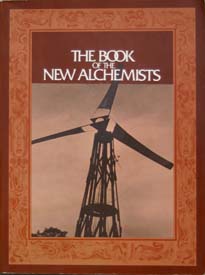
The Book of the New Alchemists, Edited by Nancy Jack Todd, E. P. Dutton, 1977, 174 pages, paperback, ISBN: 0-525-47465-X "A few years ago, a small group of artists, scientists, and thinkers concerned about the rapidity of the Earths destruction and the impending disintegration of social and moral values, joined together to form an organization with a name of peculiar significance for our time" The New Alchemy Institute. The Book of the New Alchemists is a document of a living experiment begun in 1969 by a group of people concerned with what they saw as an approaching ecological crisis. Eschewing the unsustainable in the dominant culture, they chose to drop out and create a micro-culture and economy with their own radical methods. This book is a document of their optimistic experiment in self-reliance. We like this book because it has important analyses of the dangers of pesticide use on crops, beginners accounts of composting, poems, manifestos, and a chapter on women and ecology. It provides loads of information on how to build your own bio-shelters and aquaculture systems. Their analysis of the human relationship to the earth, presented in a personal and direct manner are interspersed with art and poetry to make for an engaging and unifying experience. The New Alchemists created and documented their use of Living Machines. Based on the environment of wetlands, Living Machines are sophisticated micro-ecosystems that do a variety of functions simultaneously. The Living Machines process human waste as food for microorganisms in water containers, the waste of the microorganisms serve as food for vegetables and fish that humans can eat. The New Alchemists used aquaculture and created bio-shelters (one example is pictured on page 3) systems that people lived with and in that were sensitive to the needs of the plants, animals, and environment that everything shares. This is interesting because it places humans back into the ecological cycle rather than trying to manufacture or design a solution to a problem derived from the very sources of the problem. 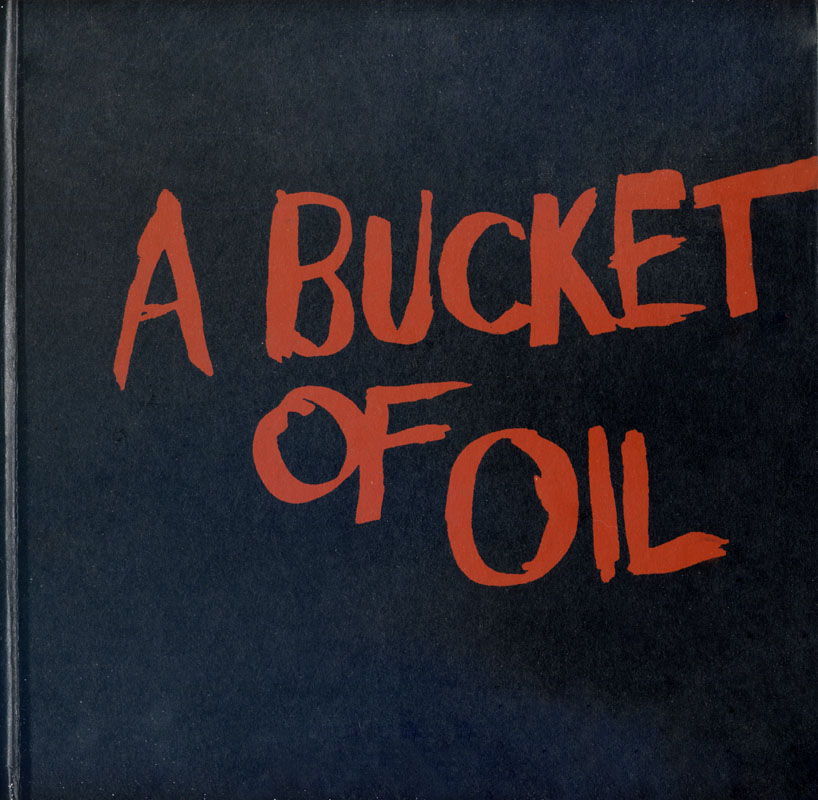
A Bucket of OIl: The Humanistic Approach to Building Design for Energy Conservation, By William Wayne Caudill, Frank D. Lawyer, and Thomas A. Bullock, Cahners Books, 1974, 88 pages, hardback, ISBN: 0-8436-0126-4 This book is a chilling echo of our own times. It is a clear reminder that we have not progressed as much as we have needed to - in developing new energy sources and architectural designs - since the time it was written. The authors were deeply concerned about the energy crisis the country was going through and the amount of ecological devastation that people were unleashing on the natural world due to energy consumption. The forward to the book states: Despite warnings over the years from high places the energy crisis shocks us all. Typically we react by clamoring for more, bigger and different sources of energy. For the first time we start seriously to explore the heat of the sun, the power of the winds and the rains, the warmth of the earth, the chemistry of the atom - wherever we may find and capture energy from sources available, renewable, and infinite. (Page 3) With this book we get an interesting glimpse at a time of growing awareness of possible alternatives to non-renewable fuels. This books stares the looming disasters in the face with a bold optimism that inspires us. The authors, experienced architects, offer a range of solutions to conserve energy, make buildings more attuned to the natural world, and to think differently about how we conceive of architecture. They are interested in design solutions that provide quality experiences for building inhabitants while simultaneously reducing energy consumption and waste. They write: Energy, people, buildings. Thats what this book is all about. Throughout you will find these underlying premises: 1) Buildings today waste energy; 2) through proper design the wasted energy can be saved; 3) energy shapes buildings; 4) buildings shape the way people live, work and play; 5) energy can be saved without sacrificing esthetic and human values. (Page 8) There are many drawings, diagrams and photographs throughout the book that readily demonstrate the authors ideas. The authors pay close attention to how a building interacts with a site as well as how buildings fit into an overall landscape and urban plan. 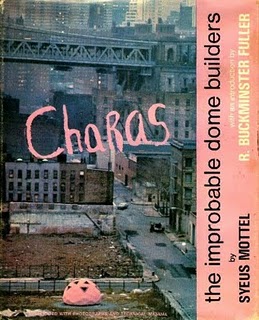
Charas, The Improbable Dome Builders, By Syeus Mottel, Drake Publishers, Inc., 1973, 191 pages, hardback, ISBN: 0-87749-490-8 This book is dedicated to everything that is. This simple dedication begins Charas, the Improbable Dome Builders. The book is a document of a Lower East Side community and their struggle to build a geodesic dome, beginning in the early 1960s with struggling New York City street life and systemic racism. Several men who would become CHARAS members led or were involved in gangs and moved in and out of prison while watching friends and loved ones succumb to drugs and violence. Carlos Chino Garcia and Angelo Gonzalez, Jr. two friends from the Lower East Side and involved in gang life from an early age, start the CHARAS story. Angelo, after serving a long jail sentence and Chino, after spending a year in Puerto Rico at the request of the NYPD, meet up again in their old neighborhood with the idea to do something for their community. The two men were inspired by Lyndon B. Johnsons Great Society plan which sought to eliminate poverty and racial injustice in America. Talking at a party they joked that they would start the Real Great Society in their neighborhood. The joking led to long discussions drawing in friends and neighbors in an apartment space on East 6th Street. Finally, the group was able to obtain the entire building as a meeting and organizing place to launch the Real Great Society in earnest. Much of what the Real Great Society project was about was developing community autonomy through self-directed economic and education projects. The project managed to do a lot for the neighborhood forming several businesses and setting up several storefront schools for teaching reading and basic math in East Harlem and the Lower East Side. This project brought national attention to the Lower East Side. Despite its initial successes the group continued to do research and work toward finding the answer to affordable housing. This led them to contact R. Buckminster Fuller, after Chino learned of his design work. Fuller came and spoke at the Real Great Society loft to a rapt audience. This meeting led to the formation of CHARAS, an acronym of the first names of the original six members of the group, committed to implementing Fullers ideas for housing in their community. The original idea was to build a dome in upstate New York so that city dwellers could experience fresh air. Budgetary constraints forced the group to begin building on an abandoned lot in the city. The group worked closely with Fullers assistant Michael Ben Eli, a PhD student in London at the time who often traveled with Fuller. In a strange collapsing of scale, Ben Eli commuted from London to the Lower East Side to teach the CHARAS members and friends about the applied geometry of dome building. Several CHARAS members had not graduated from high school and had a skeptical attitude to teacher student relationships. According to the book, there was a long period for CHARAS members and Ben Eli as the learned to communicate with each other. The commitment to the idea finally led to the building of a dome. Marriage, childbirth, death, and the need to work to support families form the backdrop of the CHARAS story to build a dome house. The process as described in the book is long and arduous and the dome house does not clearly produce lasting change in the community. Rather the process initiated by the former gang members of creating alternatives to poverty and the violence of street life through collective work is the most salient aspect of the book. The book includes an introduction by Fuller and plans for dome building in appendix. Domes were a touchstone for liberation through design, and captured the imagination of many people; this is one of the more interesting stories of their impact on radical culture. Charas, The Improbable Dome Builders (high resolution) 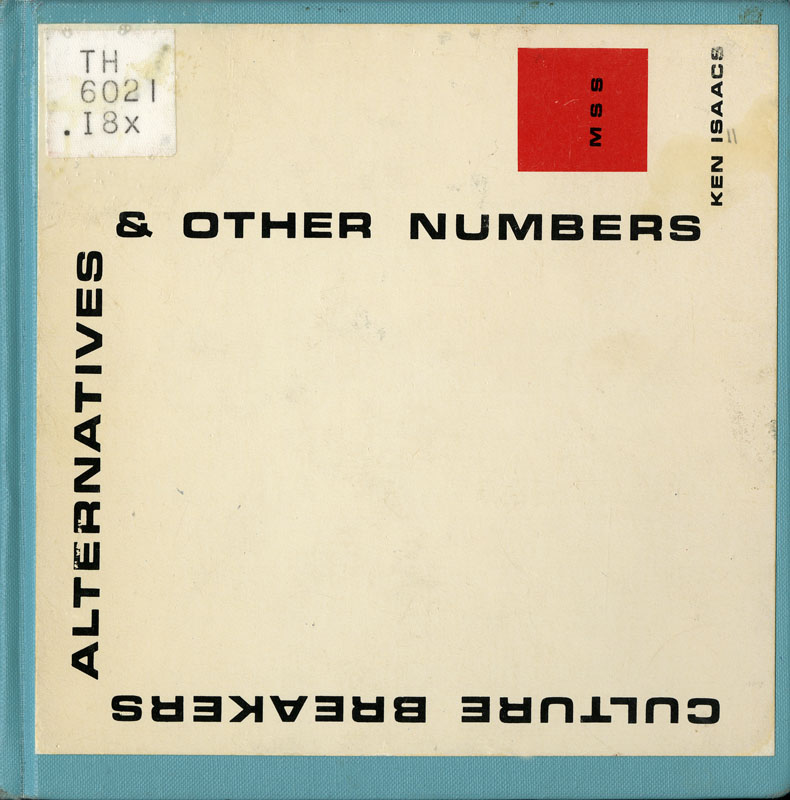
Culture Breakers: Alternatives & Other Numbers, Ken Isaacs, New York: MSS Educational Publishing Company, 1970, 190 pages "This is the context of our time and the field of all action." Thus begins Ken Isaac's perfectly square book Culture Breakers: Alternatives & Other Numbers. Isaacs an architect and former design educator, is a self-described survivalist "concerned with the survival of all people." This small book, based on a decade or so of research in the late 1950s and the 1960s, describes designs for living lightly on a small planet. In Culture Breakers, he presciently draws attention to shrinking polar ice caps and makes connections between the ways our living spaces affect how we survive in the world. Isaacs, concerned with ecology, considers how design can be more integrated into systems that function together. But, Isaacs main focus in Culture Breakers, is just that: breaking culture. He presents several plans for breaking down "old culture" so that people can be free to experience new ways of thinking. His designs for living and configurations of images are "culture breakers" meant to free individuals from traditional ways of learning, thinking, and experiencing the world. The book includes sketches of several of his "space framing" designs, like the "Microhouse" and the "Knowledge Box". The basis for all of his designs is the "Matrix" network, which is a modular system of squares that can be built from off-the-shelf materials, like steel piping, wood, or bamboo. Matrix designs can be quickly framed up to make indoor and outdoor 'living structures' to provide both shelter and a different way of organizing small spaces. At the time that he was conducting research and writing, Isaacs would have been part of a small network of young professionals loosely termed 'urban nomads'. 'Urban nomads' were concerned with design ingenuity and making the most of post-industrial materials to better facilitate a mobile contemporary lifestyle. Other books in this library that fit the genre include Nomadic Furniture 1 & 2. Isaacs was a radical among this group, not wholly concerned with lifestyle design, although this was certainly part of his research, Isaacs ultimately hoped to change the way people learned and thought. This is most apparent in the later half of Culture Breakers when he discusses his plans for the Knowledge Box, a cube with an external projection system that submersed participants in a room full of images. Isaacs built the Knowledge Box with students after several different iterations of the idea. An earlier version of the submersion system was the "Pholage" a neologism combining photography, montage, and collage. Isaacs collaged photographs, unedited, into a small space with the intention of changing the way a viewer makes connections in her mind about society and the human condition amidst a jumble of information. Isaacs's muse in this book is certainly information and mobility. In his quest to break culture, Isaacs moves from the static Pholage to the moving image. Focusing on how space shapes our thinking he includes designs for mobile structures that can shift consciousness, like the Torus 1, a long modular tube that when installed will allow for slide and film projections on four walls, finally settling on the streamlined cube of the Knowledge Box design with projections surrounding participants. Isaacs did much of his research in design schools like The Illinois Institute of Technology, Cranbrook Academy of Art and the Rhode Island School of Design. He was an educator so his concern for shifting the way people think was primarily directed at students. The Knowledge Box design, that concludes the book, is an extension of the "Space University," an immersive educational system where students could be surrounded with ideas. Isaacs plans and ideas appeared in popular magazines of the day like Life, Look, House Beautiful and Popular Science Monthly, where he was a design consultant. Culture Breakers focuses on the way spaces shape our consciousness and can encourage or hinder the way we learn and relate. Isaacs takes on daily living spaces and ultra-specialized learning environments in his vision to make a new world. This book is a gem: come for the beautiful design sketches and stay for the utopian ideals. Culture Breakers Alternatives & Other Numbers (low resolution) 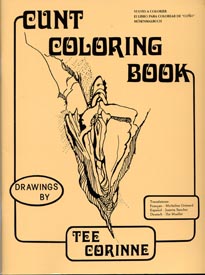
The Cunt Coloring Book, Drawings by Tee Corinne (self-published in 1975), Re-print by Last Gasp, 1988, 48 pages, paperback. staple-bound, ISBN-13: 978-086719-371-8 The Cunt Coloring Book by artist Tee A. Corinne translates her detailed drawings of vulvas and labia into graphic, colorable, black and white images. The book was first published in San Francisco in 1975, and has since been reprinted several times (our copy is a reprint). Corinne began to create the drawings as she was coming out as a lesbian and a feminist. She did the drawings in private, at first sketching her own labia, but in 1973 began attending consciousness-raising style workshops with other women and drawing anyone who would pose for her. Corinne believed that reclaiming labial imagery was a route to claiming personal power for women. The Womens Health Movement, concurrent with the Womens Liberation movement, worked to change the power dynamic between women and their health care providers, among other political goals including the right to a safe and legal abortion. The movement used many tactics from public demonstration to self-cervical examinations, but a large part of the womens success was changing the doctor-patient discourse by researching and writing their own health guidebooks and informational pamphlets. Perhaps the most well known of these books is Our Bodies, Ourselves by the Boston Womens Book Collective. A unique component of the Womens Health Movement literature rooted firmly in the do-it-yourself/self-knowledge/self-education paradigm was the inclusion of their own medical illustrations. Medical diagnosis privileged the visual understanding of womens bodies, and women activists, reclaimed the power in seeing how they saw their own vulvas and cervixes in consciousness-raising groups and sharing their findings in self-published texts. Corinnes liberatory artwork is an example of these larger trends in the Womens Health Movement that were part of the national political and social climate. Her project, like many womens health groups, sought a physical understanding and celebration of the female body. Corinne, aware of the importance, even in an art work for questioning how we get information, and who controls it, says of The Cunt Coloring Book that she, liked the idea of combining a street term for genitalia with a coloring book, because both are ways that, as children, we get to know the world. Check it out alone or with a friend! 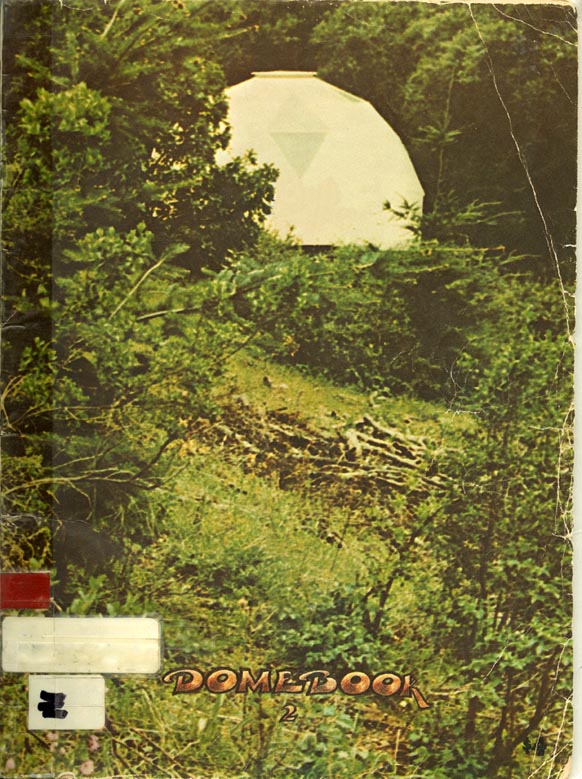
Domebook 2,by Lloyd Kahn + friends, Pacific Domes California, May 1971, distributed by Random House, 133 pages, paperback "A dome is just a portion of a sphere." Lloyd Kahn is at it again, with Domebook 2. Kahns book Shelter was one of the original books in the Library. Kahn says about Domebook, Its much easier to build, than it is to write about it. True to this sentiment Domebook contains over 100 pages of beautiful images and illustrations with brief and clear instructions both written and drawn and conversations about inspirations for building shelter out of domes. Buckminster Fuller, the key thinker behind Kahn and others fascination with dome building, gave away his original design for what he called the Sun Dome in the May 1966 issue of Popular Science. The plans, after Fuller improved them, were later sold for $5 by the magazine. Fullers geodesic geometry is created with mathematics, wood scraps and staples; a model that Kahn took up with a passion, continuing with Domebooks 1 & 2 building domes around California. Domebook 2 was written after many years of personal research with groups of people from the high school students and teachers at Pacific High School in California to the radical arts group Ant Farm, known for the inflatable structures to willing friends who wanted to experiment with their living situations. Make models, words of wisdom and encouragement from Kahn and friends. The group made multiple models before building their domes. The many domes that are included in the book were built in varied landscapes with materials from wood paneling, polyethylene, vinyl, Plexiglas, hot glue, bolts, and even red wood scraps and staples. The book notes that people have built shelters for thousands of years using the materials at hand inspired by architecture of necessity. Kahn laments that most likely too much money was spent on the creation of domes out of man-made materials, when a sufficient shelter could have been built from more local and inexpensive material. Despite the truth in this statement, the designs in this book built with a blueprint of mathematics are about a shift in consciousness around ideas of joy, authorship in architecture, and creative use of space. 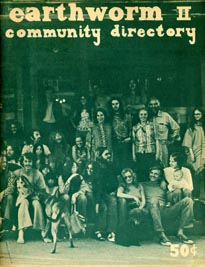
Earthworm II: Community Directory, By The Free Prairie Community, 1973, 52 pages, staple-bound This is a community directory for an underground network of groups, spaces, publications, and stores for a Central Illinois community of radicals, mainly centered in Champaign-Urbana, Illinois. Publications like this one, self-published and distributed through underground networks, were an important component of spreading information and organizing. Guides like this show how movements happen and spread. The earthworm II: community directory details what its producers call the Free Prairie Community (FPC), which for the amount of distance the groups cover is surprisingly diverse. The groups, which all fall loosely under the FPC umbrella, listed in the guide purport to cover issues from gay liberation, independent media, both press and video, art and food co-operatives, drug recovery, alternative learning sites, daycare, and environmental issues, among other things. The
authors of Earthworm II: Community Directory had a space in Champaign-Urbana,
in the early 1970s. They published this book to show that the various
groups and spaces in their small community were actually working towards
greater social change. They articulated five points about what the FPC
entailed or could become: This community of young, mostly white people, trying to build an alternative to the dominant culture didn’t last long, but remnants can still be seen around Champaign-Urbana today. We currently live in Urbana, so this book has added significance to us. What also makes it interesting to us is its earnest and awkward working through of ideas and notions of community in such a public way. 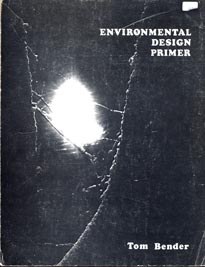
Environmental Design Primer, By Tom Bender, Schocken Books, 1976, 207 pages, paperback, ISBN: 0805205136 Tom Bender is an architect who was at the forefront of the sustainability movement. This book, published in 1973, is a scrapbook collection of musings, quotes, images, and philosophies culled from a myriad of sources. The book is a starting place for Benders personal investigation of how we can live lightly, in harmony with the land. The book is a relevant document of thoughts in the environmental and sustainability movements of today, and it is easy to get lost in the wandering collage like style of the books design. 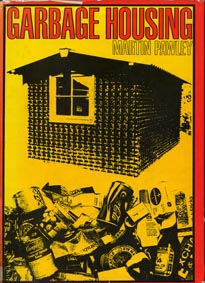
Garbage Housing, By Martin Pawley, Krieger Publishing Company, 1975, 118 pages, hardcover, ISBN: 0470672781 Industrialized global capitalism has failed to provide affordable housing for everyone. Yet, it is possible to get carbonated soft drinks in aluminum cans into the hands of millions of people worldwide. Martin Pawley looks at this conundrum and rightfully asks how we could let this happen. He demands that we ask more of the consumer goods we make, that we learn from them to address all the problems that our consumer culture has generated. His solution to housing crises is to build dwellings out of garbage to design our garbage to better accommodate the housing needs of those left out of consumer societys benefits. This book is captivating. It investigates the use of cast off materials in the slums of Chile. An entire chapter is devoted to the Heineken World Bottle (WOBO). In 1960, Alfred Heineken created the WOBO interlocking and self-aligning bottles to hold his well-known beer for Caribbean consumers. Once the bottle was emptied, it could be used to build a shelter. The WOBO demonstrates what Pawley refers to as secondary use, that is, everything we design should be made with further uses in mind. 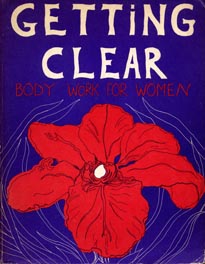
Getting Clear: Body Work For Women, By Anne Kent Rush, Random House, 1973, 290 pages, paperback, ISBN: 0+394-70970-5 Written from the womens liberation perspective of the personal is political Getting Clear encourages women to get to know themselves by getting to know their bodies. It is a womens health book advocating self-education and self-healing. The book encourages the practice of yoga, massage, talk therapy, and spending time with other women to generate personal energy, which can translate into activism. Rush writes as if she is in a rap session at her womens group. It is important to note this language because consciousness-raising groups were an influential element to spreading ideas of womens liberation. Rush explains consciousness raising groups: what they are, what a typical session sounds like, and how to start your own. The book documents a time when many women worked to generate knowledge about their bodies and their lives, thereby gaining power over the medical and political discourse surrounding their reproductive and emotional health. Rushs book operates on a personal level advocating knowing ones body to know oneself, but it also operates on a larger scale with the power of collective voices generating collective knowledge. 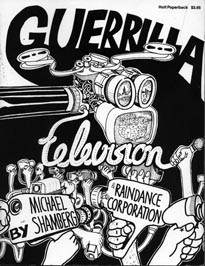
Guerrilla Television, By Michael Shamberg & Raindance Corporation, Holt, Rinehart & Winston, 1971, 108 pages, paperback, ISBN: 0-03-086735-5 The Portapak revolution has arrived and You are the information! Sony introduced the Portapak video camera in 1968 and this book brings together the counter-cultures response to this new technology. Michael Shamberg was part of the Raindance Corporation video collective created to respond to the possibilities of portable video and to be an alternate culture think-tank. Raindance also published the magazine Radical Software. Guerrilla Television is a book about the creative potential of information exchange networks. It is perhaps the one Library book where much of its ideas are actually seen in active practice today with the rise of the Internet. It is critical of both dominant media and typical radical responses to new technology such as the hacking of broadcast networks advocated by Abbie Hoffman. True cybernetic guerilla warfare means re-structuring communications channels, not capturing existing ones, says Shamberg. He describes a time of technological evolution, commenting on the dominant cultures attachment to the product-based economy and the hardware required to produce products, we are now in a process-based economy where software allows us to realize new modes of social organization and interaction. Guerilla Television, on top of the information technology revolution, was an early advocate of questioning intellectual property laws, equating rigid control of information with outdated power structures preventing real cultural growth. Shamberg in the Meta-Manual section of the book, writes essays about money as a leftover in the new information economy of the old product-based economy, the problems with the American education system, the problems with print media, the rise of the service economy, and the symbioses of media to meet the demand of the information economy. Shamberg is critical of the ever-growing desire to know more, suggesting instead that to survive we ought to know differently. Beyond critical essays in the Meta-Manual, the Manual section contains practical ways to interact with video feedback. It contains examples from the Videofreex, Peoples Video Theater, and the Media Access Center, among others. Video becomes an analytical tool for interacting with the world, and like the motto for the Whole Earth Catalog that inspired Shamberg in writing Guerilla Television, we need access to tools. 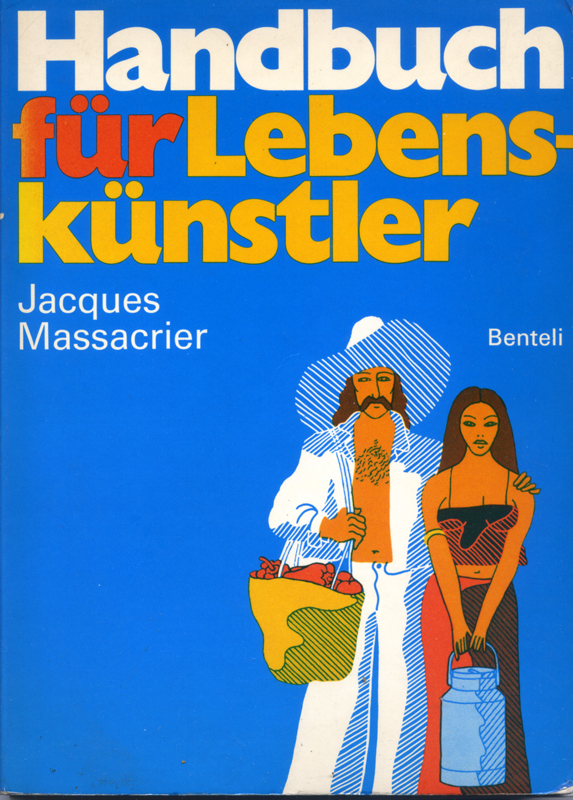
Handbuch für Lebenskünstler, by Jacques Massacrier, Benteli Verlag, Bern, Switzerland, 1974, ISBN: 3-7165-0136-2 Jacques Massacrier, the author of this book, left his job and modern conveniences behind for a simpler, more ecologically sustainable life. He took his family with him where they explored the implications of their decision. Massacrier's book was initially published in French and can be seen in total here: savoir-revivre.coerrance.org/savoir-revivre.php. An interview with the author, and pictures of his family living in their new home are here: savoir-revivre.coerrance.org/paris-match.php Translation of the back cover of the book provided by Sabine Horlitz: More and more people give up their highly paid jobs in order to lead a simple and fulfilling life, somewhere in the countryside, on a lonely island, far away from civilization and its stress promoting achievements. Many have the wish, but most of the time the dream of a simple life stays only a dream throughout a rushed (or: hunted) life. Download: Handbuch für Lebenskünstler (high resolution) 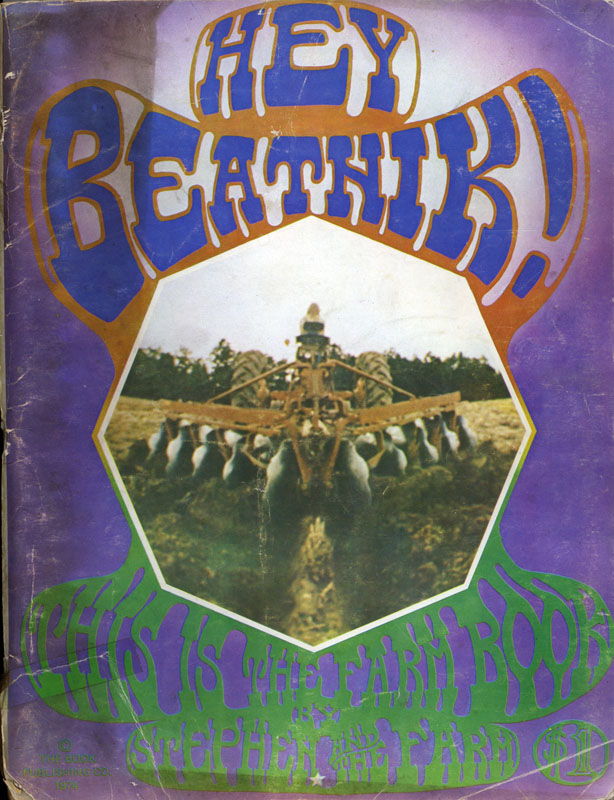
Hey Beatnik! This is the Farm Book, By Stephen Gaskin, The Book Publishing Co., 1974, 104 pages, paperback, ASIN: B0006W3AZE The Farm is a long running intentional community near Summertown, Tennessee, in the south central part of the state. It sits on 1700 acres and estimates of the current population range from 175-200 people. The Farm was started in 1971 by Hippies who migrated from San Francisco, making the trek in a large iconic caravan, to rural Tennessee. They were following Stephen Gaskin, a charismatic hippie whose "trips" he later calls them "visions" provided the spiritual connection that he and many others were looking for in building a place like the Farm. This book, written by Stephen Gaskin after 2 years of living at the Farm, gives you a good sense of the values and the activities of the people, at this point around 600, that lived there. The book chronicles their caravan, which took 7 months to land them in their current locale. It wasn't an easy journey and the book lays out some of the problems they encountered. It chronicles their growing awareness of farming and raising their own food, their interaction with neighbors, especially older farmers who they found out were an incredible resource of practical information about agricultural practices in the region. The book encourages others to follow and make their own situations by sharing information and experiences in an open and direct manner. The book today is a study in the groundwork for an intentional community. Page 15 is devoted to enumerating exactly how many acres had to be used to generate the produce needed to sustain their population for one year. There are pages on raising horses, their communal system of banking, building methods, healthy eating, home birthing, and some idiosyncratic gems like "tripping instructions." This is not what you think and has nothing to do with drugs; those are are covered later in the book. Rather "tripping instructions" describe the interactions and relationships of Farm folks. The people of the Farm valued truthfulness, as they saw it, and challenging each other on their shortcomings. This page lets a visitor at that time know a little of what to expect from the people who lived there. Large parts of Hey Beatnik! are written in Hippy-speak. Changing language to more accurately reflect a culture shift and create a revolution was a popular strategy at the time, and one held dear by the Farm community. The language shouldn't distract you from the very serious, and continuing, utopian experiment these folks undertook. The Farm is well known for many things, among them the incredible amount of work they have done on home birthing (see Spiritual Midwifery (Click title), by Ida May Gaskin). You can visit the Farm today. They offer classes in midwifery, permaculture, eco-village building and more. This book was brought to our attention, and generously provided in PDF format, by Public Collectors: www.publiccollectors.org.
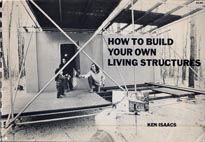
How To Build Your Own Living Structures, By Ken Isaacs, Harmony Books, 1974, 136 pages, sprial bound, ASIN: B0006C58MM This book is a beautiful guide about how to make a variety of flexible experimental indoor interiors, storage units, and a microhouse. The microhouse is a flexible creation of architect, Ken Isaacs. The modular design is based on stacked tetrahedrons, which can be moved in and around each other providing shelter and dividing living space in a creative way. The book gives you step-by-step instructions with plans for many different versions of Isaacs original designs interspersed with ideas about simplicity, and getting rid of our personal possessions. The book is type written and spiral round in a nice Do-It-Yourself aesthetic, and Isaacs writes in a genial manner as if he were sitting across the table from you. He muses on the philosophical meanings of surplus and uses the designs as a means of addressing life as whole; a simple place to raise a family and house extended family that has a low impact on the surrounding natural environment. Download: How To Build Your Own Living Structures. 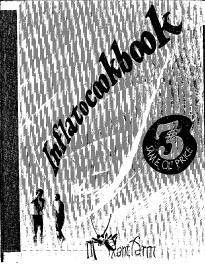
Inflatocookbook, By Ant Farm, self-published, 1973 (second edition), paperback According to Ant farm, inflatable structures can be used for creating temporary environments that serve as practical shelters from the elements, or more whimsical interactive spaces, and in some cases as both. Ant Farm began as an experimental think tank of architects to create new ways of designing shelters. They are better known now for the use of video in documenting their work, like Media Burn (1978), where they drove a Cadillac into a tower of burning televisions. The Inflatocookbook is a great example of a self-published how-to book opening up the information for inflatable structures to anyone who wants it. Ant Farm starts readers out with the basic concept of how to fill a plastic bag with air and moves up from there. Their detailed floor plan for the The Worlds Largest Snake an inflatable media center in the shape of a giant rattle snake, is a fantasy idea of where the combined sensibilities of radical architecture and interactive media could go. The book is a useful combination of fantasy and technical information for exactly what materials you will need to get going on making your own inflatable structures. Download: Inflatocookbook. 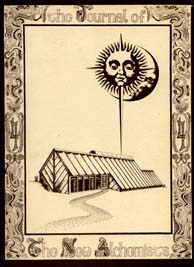
The Journal of The New Alchemists #4, Edited by Nancy Jack Todd, The New Alchemy Institute, Woodshole, Massachusetts, 1971, 148 pages, paperback “ To restore the Lands, Protect the Seas, and Inform the Earth’s Stewards,” states the directive guiding the members of the New Alchemy Institute (NAI). The NAI – operating from 1971 - 1991 – researched and developed several inuential sustainable design projects. Their research was informed both by a highly critical stance towards industrial agricultural practices and concern for living in balance with the environment. Enclosed systems for shelter and food production, systems that supported themselves were one of thier key interests. The NAI has evolved into the Green Center in Cape Cod, MS; their prescient original research is highly relevant today. Nancy and John Todd, and Bill McLarney, founded the NAI. It became an international movement for science and lifestyles in harmony with natural ecosystems. Nancy Todd edited The Journal of the New Alchemists from 1973-1981. The issues are similar in to their The Book of The New Alchemists. They present the issues and areas of research that the NAI was involved in, from bioshelters, and energy use, to the development of the Ark, a living house, and aquaculture system. John Todd and McLarney, former marine biologists, pursued the research and development of multiple aquaculture projects: systems for growing sh for food. This issue of the Journal reports on the “Solar Algae Pond” project, which John Todd was developing in Massachusetts, while McLarney was working on the “Cage Culture” project in Costa Rica, an NAI outpost. Another project was the Miniature Ark a prototype for future aquaculture projects. It consisted of three greenhouses, and a “closed-loop river.” In the bottom house, tilapia sh lived, eating and excreting. The top house processed the sh waste into nutritious fertilizer for the middle house where greens were grown. Todd and McLarney continued to improve on the prototype. The Solar Algae Ponds were single clear containers of water, sh and algae. The algae grows more with in- creased sunlight coming in on all sides of the clear container, and sh feed on the algae. The New Alchemists’ publications contain articles written so that readers will understand the science, design, and environmental principles behind each project. The folks at NAI wanted readers to reproduce their ex- periments. They were calling for a sea change. Their goal was to create alternative methods for feeding and providing shelter for the Earth’s growing population. Some of the former members of the NAI continue to push their designs forward after many decades of hard work. 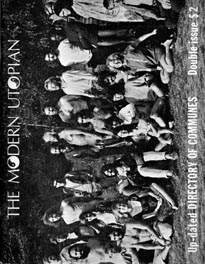
Modern Utopian: Up-Dated Directory of Communes, Double Issue: Volume 4, No. 3 & 4, Berkeley, California, 1970 The Modern Utopian is a magazine comprised of articles and resources for communal and intentional communities around the globe. It includes an exhaustive list of these communities names and addresses. A few of them, such as Ant Farm (see their Inflatocookbook in this guide) or Drop City, were started by artists and have left a legacy of innovation in artistic, design, and counter-cultural practices. The Modern Utopian is special because it presents an honest attempt at working through ideas with lived experiments and documenting them so that others may learn. Some seem naive to us today like How to make a group marriage. But, the openness and vulnerability needed to build a successful network of people working for change is apparent on the magazines pages. It includes articles and snippets about communes in Japan, the Netherlands, and the lost history of an Afro-Canadian commune that began as an outpost of the Underground Railroad. Stories of failed communities like Freefolk, a small, rural anarchistic-type commune, or Sun Hill Community in Massachusetts are included as cautionary tales for others desiring to create or live-in an intentional community. Free Folk fell apart, the author tells us, because of the many strong-willed individuals who had a hard time resolving conflict and overcoming unspoken resentment a fate of many such social experiments. The editors collect lists of books and records that inspired them collaged next to letters from readers. The editorial group also published directories of free schools, personal growth initiatives, nudist colonies, and social change networks under the title Alternatives!. The Modern Utopian is similar to the Whole Earth Catalog, in how both connect individuals to larger movements and information. It is most exciting and relevant to the Library, because it is a poignant and diverse example of the way social change networks were being built. 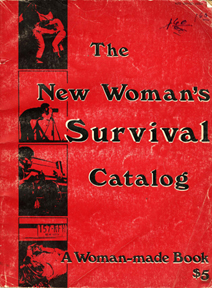
The New Woman's Survival Catalog, Kirsten Grimstad & Susan Rennie, eds., (Berkeley Publishing Company:1973, New York), 212 pages, paperback, SBN: 698-10567-2 The New Woman's Survival Catalog is a guide book for what was the burgeoning feminist movement. The editors concieved the catalog as a tool for developing an "alternative woman's culture." The book is similar in style to the Whole Earth Catalog and numerous other movement builing tools published at this time, but it is directed at specifically feminist infrastructure projects. The editors highlight women-run presses, bookstores, law firms, credit unions, and media outlets, as well as books and art made by and for women. Chapters include: Communications, Art, Self-Health, Self-Defense, Work and Money, Building the Movement, and Getting Justice. In each chapter, descriptions with addresses and contact information are included so that a reader may contact their desired resource. Today this provides an historical document of the reach, diversity and scope of the second wave feminist movement. For instance, there are a handful of feminist women's health centers in operation today, but the Self-Health chapter includes addresses and descriptions of feminist health initiatives in several parts of the United States. Feminist projects are highlighted throughout each resource section. The Feminist Studio Workshop, home to celebrated artists Arlene Raven, Shelia de Bretteville, and Judy Chicago among many others, is featured as an example of culture shaping feminist art practice. The Chicago Women's Graphics Collective is also featured in the Art chapter, with additional pieces by the collective illustrating numerous other sections of the book. The Graphics Collective formed out of the Chicago Women's Liberation Union in 1970. The Self-Defense section focuses on rape highlighting the Feminist Karate Union, an organization in Seattle, Washington that taught martial arts to women. Cartoons illustrating self-defense techniques are also included in this section, with tips for defending yourself if you are hitchiking. The New Woman's Survival Catalog is now an excellent historical resource documenting what was a national movement for social change and the rights of women. Download:
The New Woman's Survival Catalog (high resolution) 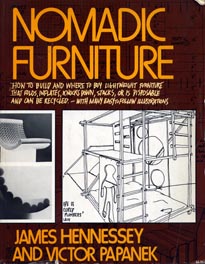
Nomadic Furniture, By Victor Papanek, Pantheon, January 12, 1973, 149 pages, paperback, ISBN: 039470228X Nomadic Furniture is a simple how-to book based on conscious design and creative materials. A design professor and an industrial designer wrote the book for those with a modern nomadic lifestyle. Much of the designs in this book are made with cardboard, light wood, or innovatively reused materials. All the designs are economical and creative. The authors relate their own experiences with the use of the designs, as well as how one might incorporate them in day-to-day life. The book covers everything from how to make a bed to building a childs car seat from cardboard. It provides detailed measurements and descriptions of the tools you will need to build the items in the book. 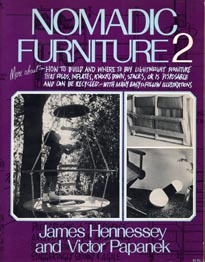
Nomadic Furniture 2, By James Hennessey, Pantheon, 1974, paperback, 153 pages, ISBN: 978-0394706382 The second volume of Nomadic Furniture is every bit as engaging as the first. This volume contains projects from hanging lamps to kitchen tools to various kinds of folding and adjustable chairs. Highlights include instructions on how to make playgrounds from old car tires as well as elaborate and abstract rope and wood tree houses for children. The authors of both volumes want readers to make the projects in the books as well as use them for inspiration on original creative projects. They even provide many blank pages at the end of each volume to make your own notes. 
A Pattern Language Towns Buildings Construction, By Christopher Alexander et al, Oxford Unitversity Press, 1977, 1171 pages, hardcover, ISBN: 978-0-19-501919-3 A Pattern Language came out of research done primarily at the Center for Environmental Structure at the University of California, Berkeley, with supplements from international researchers. The authors hope the book will lay the basis for an entirely new approach to architecture, building, and planning, which [they] hope replace existing ideas and practices entirely. The book was written over eight years and encompasses many of the themes contained in the Library as a whole: collective living, self-education, environmental design, and communities of all ages. The titles of some of our favorite chapters are: Network of Learning; Old People Everywhere; Children in the City; Common Land; Adventure Playground; Sleeping in Public; Hierarchy of Open Space; and Light on Two Sides of Every Room. The architects and urban planners who wrote this book examined patterns in city spaces, housing design and social interactions. The book is based on their findings, with hope that people would use the patterns to re-build their own lives. They want readers to use the patterns as guides for bringing about changes through the creation of new spaces and new ways of interacting socially. The book is thorough in its examination of the organizational structures of modern human society. It moves from states and towns down to the amount of windows a room should have for proper harmony in living. It covers most aspects of the built environment. The authors hope not that people will presume these patterns are a law unto themselves, but use them as a template for self-education to build the way they want to live rather than relying on professional architects and planners. 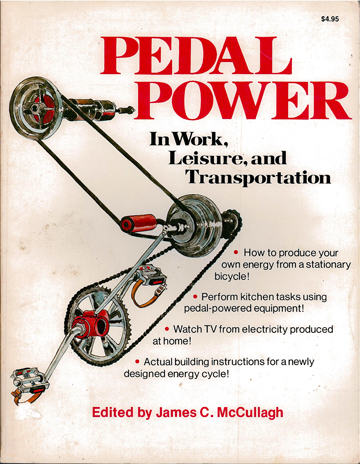
Pedal Power in Work, Leisure, and Transportation, By James C. McCullagh, Rodale Press, 1977, 144 pages, ISBN: 978-0878571789 This book is a fascinating overview of the history of pedal power, used in building ancient monuments, personal transportation, pumping water from wells and pumping air for deep sea divers, grinding grain, spinning yarn, and more. The authors present the background material as inspiration for modern applications. They ask us to return to simpler technology to do some of todays mechanized tasks. To this end, there are many detailed plans on how to adapt electrically powered tools and devices to pedal power. With the authors instructions, you can make a pedal-powered television or generate electricity for your home, and there are at least two varieties of pedal-powered washing machines. More whimsical are the instructions for making a bicycle that you can ride on railroad tracks. However, there are some rather ridiculous ideas too, the most absurd being the two-person pedal-powered plow. You can see the futility and inefficiency of the device in the illustrations. The varieties of creative uses, practical and impractical, for energy generated from pedal power make this book so terrific. Download:Pedal
Power (high resolution) 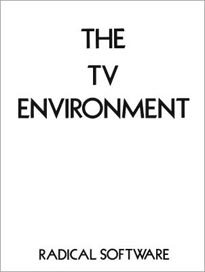
Radical Software, The TV Environment, Volume 2, No. 2, Edited by Beryl Korot and Ira Schneider, Gordon and Breach, 1973, 64 pages, staple-bound The magazine Radical Software was a project created by Beryl Korot and Phyllis Gushuny in 1970. It was a grassroots effort to provide a critical stance on the way information was disseminated. The Raindance Foundation, of Guerilla Television, a loose collective of video producers, ultimately became responsible for the publication after the first issue. The second issue The TV Environment, edited by Ira Schneider and Beryl Korot, focuses on the TV watchers, TV salesmen, TV servicemen, and the content who and what is on TV. The contents of this publication are presented in a collage fashion, combining photos taken directly from the television screen with interviews, a reader can see images of popular television personalities next to a housewife who consumes these programs. This aesthetic decision creates a visual example of how the folks at Radical Software, hoped to break down the hierarchies of information dissemination with their feedback loop. Some of the highlights in this issue include an interview with Louis Priven about his favorite television programs, which include all the cartoon shows he can watch before his bedtime at 7:30pm, and quotes from televangelists, including a young Jerry Falwell (who would go on to be a divisive public figure). There are also behind the scenes interviews with TV salesman Bernie Eckstein, and TV serviceman George Dunn. This is early do-it-yourself media analysis at its best. All the issues of Radical Software can be downloaded at www.radicalsoftware.org. 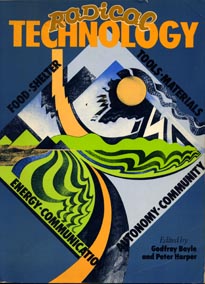
Radical Technology, Edited by Peter Harper, Godfrey Boyle, and the editors of Undercurrents, Pantheon Books, 1976, 305 pages, paperback, ISBN: 0-394-73093-3 Divided up into seven sections Food, Energy, Shelter, Autonomy, Materials, Communications, and Other Perspectives Radical Technology is a book about technologies that could help create a less oppressive and more fulfilling society. The editors are opposed to big business, and large-scale production advocating instead the power of local economies and self-education. They define technologies as tools for creating small, home, and local economies. To this end they give practical information, called recipes about how to build things like a small scale water supply, biological sources of energy, a paper mill, textiles, housing, even shoes out of car tires to name a few. Beyond the recipes, Radical Technology also tries to illustrate the intangibles created by the use of these small-scale technologies. Clifford Harper contributes beautiful illustrations of what the social relationships that could change in this society of autonomy might look like on an everyday basis. The editors comment on the difficulty and the importance of showing the intangibles, because however easy it is to give instructions for building a machine to harness wind power or start an organic garden, it is another to show reasons why to do it. The book articulates this as a difference between hardware-tools, machines, etc., and software-social and political structures, the way people relate to each other and to their environment, etc. One
of our favorite articles in the book was the house, which
generates
its own energy. Radical Technology offers
great ideas for environmentally sustainable design, and the
house is one
of them. Found in the Autonomy section of the book, it is a
response to
the ecological crisis with a way to have control, through
design, over
large-scale resource depletion. This section articulates an
important
theme running throughout the book: For many people, autonomous
houses represented the technical realization of the political or
existential
autonomy that is ...not just having legal or social control over
ones
destiny but having ones hands on the hardware. The authors
consider both rural and urban living in their discussion of
environmentally
sustainable shelters. 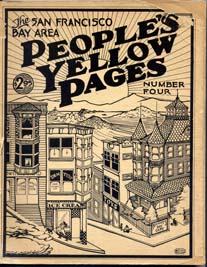
The San Francisco, Bay Area People’s Yellow Pages: Number Four, Made and distributed by Mary Donnis, Sally Harms, Winifred Mullinack, Joan Saffa, Diane Sampson, and Jan Zobel, 1975, 193 pages, paperback What
do the Turnabout Thrift Shop (secondhand clothing), Theater of Spontaneity
(psychodrama workshop), Childcare Switchboard/Single Parent Center, Lesbian
Voices (a newsletter), Black Sheep Press (printing services), and Join
Hands (a prison reform support group for gay men in prison) have in common?
They are all listed along with a dizzying number of other resources in
the 1975 issue of The San Francisco, Bay Area People’s Yellow Pages.
The guide compiled by a six-member all-women collective, bills itself
as a counter-cultural resource. It is that, but the counter-culture qualier
perhaps ignores the fact that the guide book functions as a thorough resource
for the needs of those marginalized by mainstream capitalist culture.
The women collected a comprehensive array of resources from drug treatment
programs, affordable dentists, and access to local food sources, to organizations
resisting the Vietnam War, and art collectives. Reading this guide today
gives one the sense of a powerful collective imaginary for how a city
could be organized for the people that live there. 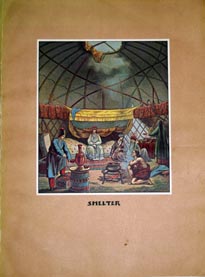
Shelter, By Lloyd Kahn, Shelter Publications, 1973, 176 pages, paperback, ISBN: 0394709918 Shelter is a catalog of construction methods of living spaces from around the world. The book focuses on homes that are creatively designed, often highlighting nomadic structures, or structures that consider the ecology of place. Its pages include everything from the unbelievable Cones of Cappadocia in Turkey homes carved into dramatic cones of rock that jut out of the earth to the Yurts of nomadic people from Mongolia to Iran. It is both an anthropological investigation of how people houses themselves and a call to live closer to ones immediate environment. The book is a great collection of images but also includes articles with environmental builders, including tips on using found or recycled materials in the creation of your own habitat. Famous hippie settlements like Drop City, and houses built onto the chassis of trucks or buses for easily driving from place to place, are well documented in this book. There is a lot of information about building geodesic domes this book is clearly inspired by Buckminster Fuller and the Whole Earth Catalog (biannual from 1968-1972 and sporadically until 1998, Its purposes were to provide education and access to tools in order that the reader could find his own inspiration, shape his own environment, and share his adventure with who[m]ever is interested. Wikipedia) It is an inspiring book, showing that it is possible to live with greater variety, intentionality, addressing our responsibilities to the environment with our habitats. 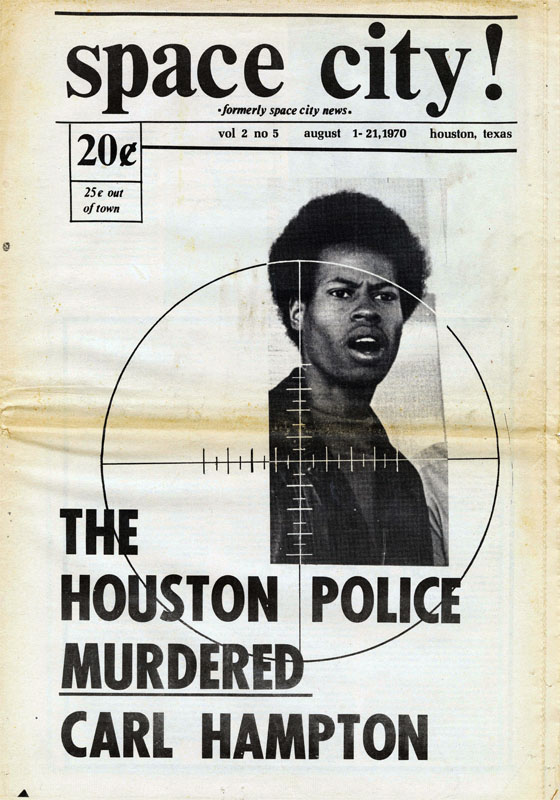
Space City!, Volume 2, Number 5, August 1-21, 1970, Houston, Texas Space City! was a radical newspaper published in Houston, Texas from June 5, 1969 to August 3, 1972. To read more about the paper, click here.

Spaghetti City Video Manual, By Videofreex, Praeger Publishers, 1973, 116 pages, hardcover, Library of Congress Catalog Card Number: 73-6976 The Spaghetti City Video Manual was written by the Videofreex media collective based in New York state in the early 1970s. This book is the radicals guide to do-it-yourself video, which maintains a non-hierarchical approach to information dissemination. David Cort, Curtis Ratcliff and Parry Teasdale, were the founding members of the group, meeting each other at Woodstock in 1969. Originally based in NYC, where the group produced programming about the counterculture for CBS, the crew soon gained members and moved to upstate Lanesville, NY. Though the CBS content never aired, the money allowed the 10 member group to purchase equipment which they made available to people through their underground television station and their Media Bus Project, which toured New York state teaching people how to use the new technology. The Videofreexs model of programming was unique because it allowed viewers to call in and request the content that would appear on the airwaves. The Videofreex produced hours of content including interviews at womens liberation rallies, with the Black Panthers, especially Black Panther Fred Hampton who was later gunned down by Chicago police, about the Chicago 6 who were falsely accused of starting riots the police initiated, and with young people trying to build a Buckminster Fuller dome, all among a multitude of other important figures and happenings from the New Left. These experiments in creating networks of media producers and The Spaghetti City Video Manual reflected the Videofreexs commitment to sharing how to use this new technology with the public. It is an exercise in challenging and changing relationships of power; the medium is the message in the Porta-pak revolution. 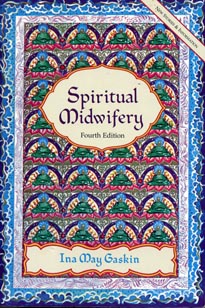
Spiritual Midwifery, By Ina May Gaskin, Book Publishing Company, 1976, 480 pages, paperback, ISBN: 1570671044 Spiritual Midwifery, now in its fourth printing, is a must read for students of midwifery but it is also an influential history of the counter culture. Ina May Gaskin and her husband Stephen Gaskin are founding members of The Farm in Summertown, TN, one of the longest running communes in the United States. The Farm was founded in 1971, Ina May published Spiritual Midwifery, in 1975 to document of the beginning of the Farm and the development of a successful out of hospital birth center, one of the first in the US. The book describes how the Farm was settled and how soon after there was a need for safe and secure medical care for pregnant and birthing women. The Farm Midwives learned how to be midwives out of necessity. An understanding local doctor aided them along with their education. The Midwives have gone on to deliver thousands of babies and are still practicing today. The majority of the book is a collection of birth stories from the women of the Farm. The fourth edition has added birth stories from the Old Amish Families near the Farm whom some of the Midwives worked with, and birth stories from people who came to the Farm just to give birth. The book also includes a practical section for midwifery students with how-to skills infused with the Farm philosophy of home birth. Ina Mays writing makes this book special, particularly in the way she frames the material. Although she never set out to be a midwife, she pays close attention to the way words affect how women perceive not only labor, but also their bodies in general. In the book, she weaves a powerful history of a group of people creating their own place in the world, calmly and peacefully, and how communication through specific language and touch plays a vital part in the success of their endeavors. There are also amazing photos of women giving birth. 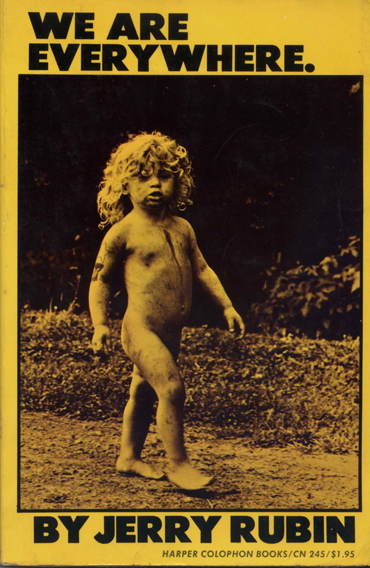
We Are Everywhere, By Jerry Rubin in the Cook County Jail, Harper Colophon Books, 1971, 255 pages, paperback, SBN: 06-090245-0 We Are Everywhere, written by Jerry Rubin while in the Cook County Jail, is a bit of a departure for the Library. It isn't a direct "how-to" manual in the ways that the other books we have included are, rather it is a celebratory book chronicling an emerging counterculture. The book was written to share ideas openly and freely. Rubin was part of the Chicago 7 arrested after mass protests at the 1968 Democratic National Convention in Chicago. He wrote the book at a time when he and others were witnessing the birth of our control society. This book joyfully enumerates and celebrates an emerging militant, resistant counter culture. It is part manifesto and part document of the emergence of a movement. The book's design is also a point of interest for us. Rich and dynamic, we are sure that it was intended to be read while under the influence of some psychotropic substance. The colors change on every page. They jump back and forth from background to frame to text, alternating with one another. The pages alternate between purple, yellow, red, green and pink. The same colors appear as strips, bands or frames, sometimes texts, on various pages throughout. Here is the tantalizing description of the book on the back cover: We Are Everywhere is Jerry Rubin's journal, written secretly in Cook County Jail and smuggled out. Jerry is a convicted felon, Yippie, enemy of the state, pothead, seven-year-old child and author of the revolutionary manifest Do It! We Are Everywhere reveals a defendant's inside view of The Conspiracy Trial. Written like a scenario, this book focuses on the Weatherman underground, the Black Panther Party, LSD, Women's Liberation, Walter Cronkite, Judaism, street fighting and the coming revolution. A color layout including more than one hundred and fifty pictures takes you on a multi-media trip, revealing the emergence of a new people.We are really happy to share this gem of counterculture history and radical design with you! Download:We Are
Everywhere (high resolution) |